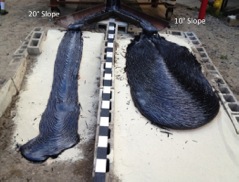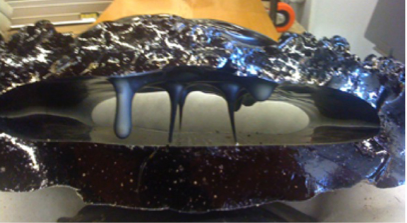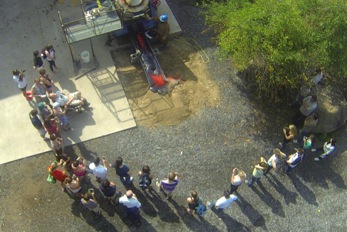Orange is the New Black (Lava): Syracuse University Lava Project
Every year the fury and beauty of volcanic eruptions burst upon the headlines. Although typically not as catastrophic as pyroclastic eruptions, lava flows are no less formidable [Cashman and Sparks, 2013]. Active eruptions at Holuhraun, Iceland and Kīlauea, Hawaii have generated considerable interest and concern. In some cases, eruptions pose significant hazards to humans, infrastructure, and commerce, but in all cases they reveal the power of one of the most fundamental and fascinating of Earth processes. Although hidden by the oceans, the entire seafloor (60% of the Earth) has been re-surfaced with lava flows over geologic time. Large areas of the continents and ocean islands are also sites of active or ancient volcanic activity. The moon and many other planetary bodies have large lava flows. Arguably, no other process has so profoundly shaped the surface of our planet. And yet, many questions remain concerning the mechanical properties and parameters determining the form of natural lava flows. Studying the behavior of active lava flows presents special challenges because eruptions are unpredictable, usually in remote locations, controlled only by the whims of Nature, ….and they can be dangerous. Even where witnessed directly, it is difficult to fully understand the mechanics of flowing lava because it is subject to so many different influences including composition, crystallinity, volatile content, temperature, effusion rate, slope, topographic variations, the nature of the surface, and the surrounding medium (i.e., air, water, ice, etc.). These influences are responsible for the diversity of volcanic structures worldwide. Remarkably, relatively few geologists have actually witnessed an active lava flow and much of what is known is inferred from detailed studies of ancient lavas [Hon et al., 1994; Cashman et al., 1998; Thordarson and Self, 1998; Thordarson and Höskuldsson, 2008] or experiments with analog materials, such as wax [Gregg and Fink, 2000].

Holuhraun eruption, Iceland, September 2014. Bauger Craters (left); Investigating an active lava flow lobe (right)
The Syracuse University (SU) Lava Project explores the behavior or basaltic lava flows through experiments with real lava flowing under carefully controlled conditions. This project is rich with opportunities to advance scientific research on lava, provide unforgettable educational experiences for students of all ages and backgrounds, and bring a rare glimpse of volcanic activity to the public. Experimental lava flows are also an ideal way to test instruments and techniques to be used on active natural lava flows [e.g., Lev et al, 2011]. Homemade lava provides an exotic medium for the creation of unique ‘land art’ constructions rendered from molten lava.

Lava flow experiments at Syracuse University using a gas-fired, tilt furnace (10 cm scale bar)
Our project is a cross-disciplinary collaboration of Syracuse University Professors Jeffrey Karson (geology), Robert Wysocki (sculpture). By merging our interests and expertise, we have developed the capability to melt and pour significant volumes (up to 400 kg-almost half a ton) of incandescent orange (~1200°C, 2100°F) basaltic lava under controlled experimental conditions. In over 100 experiments to date, re-melted (Precambrian) basalt is melted in a crucible and poured over a range of surfaces and slopes to create lava flow lobes from 0.5 to 5 m2 and up to 20 cm thick. The range of flow morphologies produced mimic those found in natural lava flow fields. Investigators from many other institutions have come to Syracuse University to do experiments linked to theoretical or field investigations of lava flows.

Effect of slope on flow morphology. Thin, narrow leveed flow on 20° slope (left); thick, broad flow on 10° slope (right). Both flows at 1150°C and constant pouring rate. 10 cm scale bar.
Over the past 3 years we have used only basaltic lava as a starting material, but future experiments are planned for a much wider range of compositions. Typically lava is poured on to a dry sand surface. However, during the winter months, similar experiments on ice surfaces provide an interesting variation on our main research theme- with visually stunning results (see link to video). Video and still cameras, infrared cameras and thermocouples are used to document the flows. Cooled lava flows are dissected for mapping the distribution of vesicles, crystals and tubes that can then be related to flow behavior and morphologies. These results can be compared directly to investigations of natural lava flows and analog experiments. Although nearly all of our experiments up to this point have been volume-limited flows, a new, much larger, coke-fired furnace is under construction that will allow experiments on cooling-limited flows as well.
A sampling of some recent experiments (see images below) include:
- Exploring lava flow morphologies as a function of T, slope, and effusion rate
- Investigating lava/ice interactions [Edwards et al., 2013]
- Formation and remobilization of spatter accumulations
- Channelization and diversion of lava flows around barriers
- Viscosity and morphology changes related to particle density in lava
- Formation and evolution of lava tubes
- Changes in flow morphology over steep topographic steps
- Formation of pillow lavas, limu o’ Pele and hyaloclastites
- Morphology of flows over different materials (ice, dry ice, gravel, sand, etc.
- Textural and magnetic (AMS) fabrics in lava flows
Video of lava flow experiments and demonstrations have been very widely viewed online (~30 M views) and featured in geoscience classrooms. Videos of many lava flow experiments are available here.

Variations in flow morphology with temperature (T), effusion rate (Q) and slope. All flows from basaltic starting material. 10 cm scale bar.
The SU facility is the only academic setting in which real lava is being poured on a scale that approaches that of natural lava flows. While this project started as a way to study the processes and products of lava flows and recreating natural structures, we quickly discovered that people of all ages and backgrounds are fascinated with watching our lava flow demonstrations. These events typically draw a diverse crowd of interested students, faculty, and the public- including K-12 students, presenting an outstanding opportunity for both formal and informal education. Lava flows have become an integral part of several classes in the Department of Earth Sciences and the Art Department. Events, such as cooking a steak over a lava flow, create unconventional ways to capture the interest of the public and students alike.

Lava demonstrations for education and outreach. Enjoying a lava pour on ice in sub-zero weather).
Watching rock melt, flow, and re-solidify is something few people, let alone those in upstate NY who live far from active volcanoes, will experience in their lifetimes. The excitement and engagement generated by these events provide an exceptional opportunity to educate the public about the scientific processes taking place and how they relate to our environment, create natural resources, and present hazards. These have been, and continue to be, exceptional learning experiences for those attending lava flow demonstrations. By ‘bringing the volcano’ to students and the public we are able to share our scientific and artistic interests and accomplish many different purposes.

The new black….convecting magma ~1200°C in the furnace crucible.

Experiments with flows around barriers at different T.10° slopes. 10 cm scale bar.

Typical sheet-like pahoehoe lava flow, T=~1150°, 10° slope. 10 cm scale bar (left). Lava flow on an ice ramp producing a very dynamic, flow with abundant limu (right).

Section of a vesicular synthetic lava flow. Sample is about 10 cm thick (left). Transparent limu o’ Pele produced by steam generated by pouring lava over wet sand. Field of view ~25 cm (right).

Cross section of a drained lava tube with preserved drips from the ceiling. Cavity is about 20 cm wide.

Photomicrographs of synthetic lavas. Basaltic glass with sparse vesicles and microlites (left); Bands of clustered clinopyroxene crystals in basalt glass; Dense bands of clinopyroxene crystals along the wall of a lava tube.

Aerial view of a class at a lava flow demonstration. Research drone image by Bryndís Brandsdóttir and Brandur Karlson.

Undergraduates from the Keck Geology Consortium dissecting a lava tube.

View More Information »
References
Cashman, K., H. Pinkerton, and J. Stephenson (1998), Introduction to special section: Long lava flows, Journal of Geophysical Research, 103, 27,281-227,290.
Cashman, K.V. and R.S.J. Sparks (2013), How volcanoes work: A 25 year perspective, Geological Society of America Bulletin, 125; 5/6, 664–690; doi: 10.1130/B30720.1.
Edwards, B.R., J.A. Karson, R.J. Wysocki, E. Lev, I. Bindemen and U. Kueppers (2013), Insights on lava-ice/snow interactions from large-scale basaltic melt experiments, Geology, doi:10.1130/G34305.1.Gregg, T.K.P., and J.H. Fink (2000), A laboratory investigation into the effects of slope on lava flow morphology, Journal of Volcanology and Geothermal Research, 96, 145-159.
Hon, K., J.P. Kauahikaua, R. Denlinger, and K. Mackay (1994), Emplacement and inflation of pahoehoe sheet flows: Observations and measurements of active lava flows on Kilauea Volcano, Hawaii, Geological Society of America Bulletin, 106(3), 351-370.
Karson, J.A. and R.J. Wysocki (2012), Do-it-Yourself Lava Flows: Science, art, and education in the Syracuse University Lava Project, EARTH, 57, 9, 38-45.
Lev, E., M. Spiegelman, R.J. Wysocki, and J.A. Karson (2012), Investigating lava flow rheology using video analysis and numerical flow models, Journal of Volcanology Geothermal Research, 247-248, 62-73, doi: 10.1016/j.jvolgeores.2012.08.002
Thordarson, T., and A. Höskuldsson (2008), Postglacial volcanism in Iceland, Jökull, 58, 197-228.
Thordarson, T.D., and S. Self (1998), The Roza member, Columbia River Basalt group: A gigantic pahoehoe lava flow field formed by endogenous processes? , Journal of Geophysical Research, 103, 27411–27445.